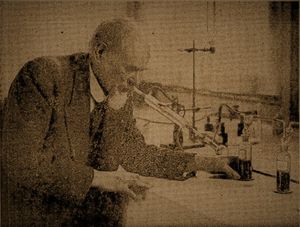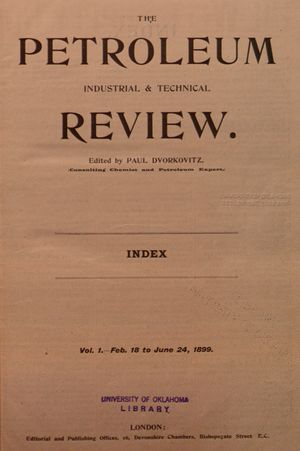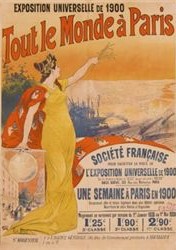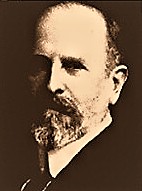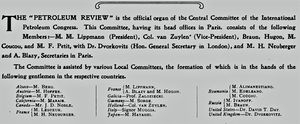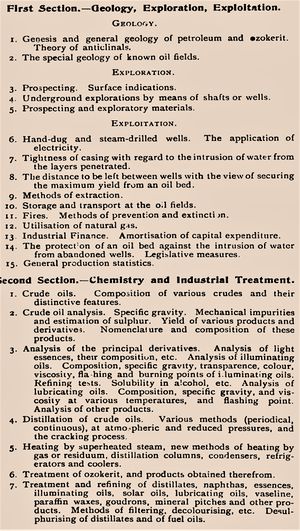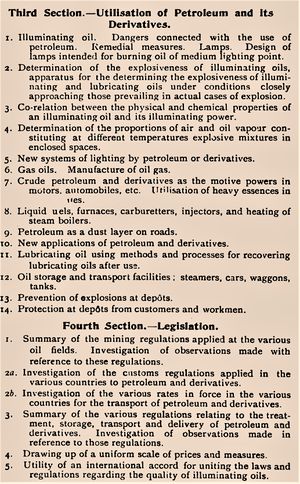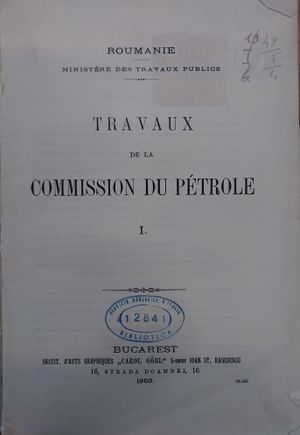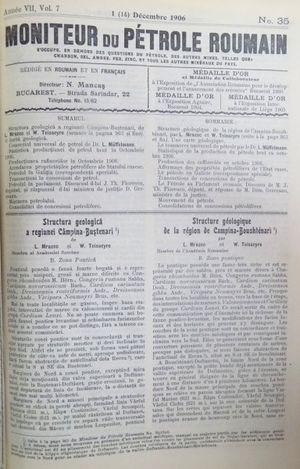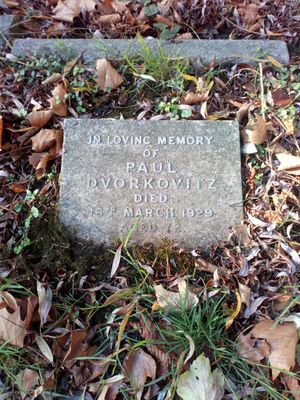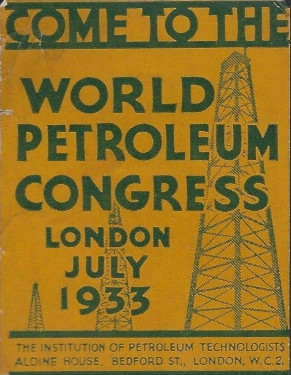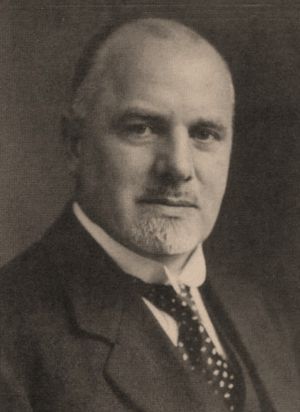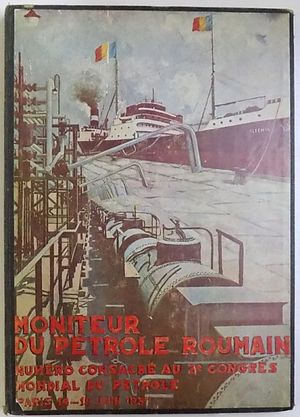International Petroleum Congress
The original version of this article was created by Francesco Gerali, 2020 Elizabeth & Emerson Pugh Scholar in Residence at the IEEE History Center
It is recommended this article be cited as:
F. Gerali (2020). International Petroleum Congress, Engineering and Technology History Wiki. [Online] Available: https://ethw.org/International_Petroleum_Congress
The motto of the Congress must be ‘Progress’, and this can only be obtained by a thoughtful consideration of the subjects beforehand, and a free ex-change of thought and opinion at the meeting itself. There are many engaged in the different branches of the industry who have made a very close scientific study of petroleum. Hitherto they have kept their own confidence; now we ask them to unclose their lips, and to tell their confrères what they have observed, what they think, and what they know. The hidden knowledge of the world contains the great secrets of progress. It is this hidden knowledge that we wish to see brought to light.
- Paul Dvorkovitz, keynote speech at the 1st International Petroleum Congress, Paris, 1900.
The early scientific and professional meetings organized for petroleum practitioners and scholars had their origins in the Editorial Notes of The Petroleum Industrial Technical & Review (often shortened as The Petroleum Review). On April 14, 1900, the Chief Editor Paul Dvorkovitz[1] reported about "(…) enquiries from many parts of the world in reference to the holding of a petroleum congress in Paris during the exhibition there (…) (FIG. 1). "
On February 1899 Dvorkovitz, a Lithuanian-born petroleum chemist and inventor, who was employed by Britain’s Petroleum Storage Tanks and Transportation Co. Ltd, published the first issue of the The Petroleum Industrial Technical & Review in London, the forerunner of the European technical journal devoted entirely to the international petroleum and gas industry, with the support of several British petroleum entrepreneurs (FIG. 2). The following year, Dvorkovitz and his partners planned the first international forum for global petroleum industry representatives - the International Petroleum Congress - to be held at the 1900 International World Fair of Paris[2] (FIG. 3).
Shortly after enquiring, Dvorkovitz announced that the International Steam Pump Company,[3] the former Worthington Pump Works Co. founded by the British entrepreneur Henry Rossiter Worthington (1817-1880), offered the Petroleum Congress organizers a conference room in their pavilion. The preliminary draft of the program was unveiled on the Petroleum Review issue of May 26, 1900, where lectures were announced dealing with the origin and geology of petroleum, drilling, chemical treatments, including distilling, refining and examination of petroleum, transport and distribution, and, the applications of petroleum products in industrial and civilian activities.
The organization of such official and specialized events were a mirror image of the maturity and complexity of the global petroleum industry at the turn of the new century. Prior to the Dvorkovitz initiative, petroleum and gas were discussed as side topics in geology, engineering and chemistry conferences often only at a regional level. In early 1900, professional titles like petroleum geologist, engineer and chemist were not yet acknowledged by academia and in corporate settings. On the other hand, cadres of professionals and academics specializing in petroleum (then called “Petroleum Experts”) were growing and looking for an international forum to discuss, share, learn, and enrich knowledge and scholarship. Petroleum as an industrial activity was older and more established than the “art & science” of petroleum itself. Since late the 1850s petroleum was synonymous of high income business, and it’s not a coincidence that the first three International Petroleum Congresses held in Paris (1900), in Liège (1905), in Bucharest (1907) were almost entirely financed by the industry and government bureaus in charge of energy matters and trade.
Paris 1900
The Paris Congress opened with a reception at the Hotel Continental on Thursday evening, August 16, 1900. The guests were received by the President of the Congress, Joseph-Georges Lesueur,[4] a former Senator of France. The Reception Committee was representative of the contemporary international industry: M. Lippman, former President of the French Society of Civil Engineers,[5] Henri Deutsch of the Rouen refinery, M. Braun from the Baku Naphtha Association, Louis C. Sands of the leading Oil Well Supply Company, W. Moore of the hosting sponsor Worthington Pumps, and A. Wilzin on behalf of the E. W. Bliss Company of Brooklyn. Among the Official Delegates were C. Alimanestianu and Dr. L. Edeleanu, from Roumania; Dr. David T. Day,[6] senior member of the U.S. Geological Survey and respected petroleum finder (Fig. 4); M. Lebedoff, from the Mining Department of the Caucasus; Professor Zaloziecki and others from the Petroleum Association of Galicia; Ben C. Truman, from California; F. A. Fitzgerald of the Imperial Oil Company of Canada; and, I. Akhverdoff representing the petroleum industry consortium of Grozny.
The Congress program featured lectures about the petroleum industries of various countries and their petroleum qualities. Albert Fauck[7] from Vienna, eminent drilling engineer, inventor and titular of numerous patents, presented on the latest drilling technologies. The paper on the origin of petroleum by Professor Carl Oswald Victor Engler (1842-1925),[8] German chemist leader in petroleum chemistry, was read by Prof. R. Zaloziecki and concerned the elucidation of Engler’s theory on the organic origin of petroleum and deriving chiefly from residues of animal life. Boverton Redwood from London delivered a paper on standards and settings in the examination of petroleum and its products. During his lecture, Redwood called for the need of an international effort to agree on and establish uniform global standards in the petroleum industry, in order to improve the quality of communication between operators and technologists. An authoritative review of the geology of petroleum was contributed by Professor Hans Höfer von Heimhalt (1843-1924),[9] in which he discussed his studies on the well-known anticlinal theory applied to the Carpathians petroleum fields. Salomon Henri Deutsch de la Meurthe (1846–1919)[10] spoke about the application of petroleum to aerial navigation, but it is true that he was thinking only in terms of dirigible balloons. However, the principles he outlined soon converged in aeroplane technology development studies.
The Congress concluded with the establishment of a permanent Central Committee for the International Petroleum Congress. It was based in Paris and aimed to coordinate the organization of the future congresses (Fig. 5).
Liege 1905
In 1904, the Central Committee decided that the 2nd International Petroleum Congress would have taken place in Liege, Belgium, in the facilities of the 1905 Exposition Universelle et Internationale, from June 26 to July 1, 1905 (Fig. 6-7). Forty-two lectures were presented and subdivided in four thematic sessions: 1) Geology, Exploration and Exploitation; 2) Chemistry and Industrial Treatment; 3) Utilization of Petroleum and its Derivates; 4) Legislation. (Fig. 8-9)
This last session was an element of innovation compared to the first Parisian congress. It was testimony to how a social science such as law was becoming increasingly strategic in the workflow of the petroleum sector.
At the conclusion of the works of the Congress, Bucharest, capital of Romania (top petroleum and gas producer country in Europe at that time) was designated host city for the 3rd International Petroleum Congress, expected in 1907. The Romanian delegation worked since the beginning with high professionality and commitment; not a coincidence the proceedings of Liege Congress were promptly published in Romania by a government agency printing (Fig. 10).
Bucharest 1907
The Romanian Organizing Committee included over 130 people and institutions. A circular edited in Romanian, German, French and English was sent to the major European and worldwide petroleum industry operators asking them to contribute to the exhibition of the Congress with publications, samples of crude and processed products, survey systems and tools, materials used in the construction of pipelines, tanks, wagons, drums, refineries plans, boilers used in distillation, lamps, stoves and other appliances. It was decided that the small artifacts could be sent directly to Bucharest; larger ones could be presented with photographs and blueprints (Fig. 11). The goal of such ambitious requests was "(…) congressmen may have in front of their eyes all that was new and exciting in the oil industry."
The Bucharest Congress took place from August 22 to September 2, 1907 and included both scientific papers and documentary visits, as the one to the petroleum terminal of Constantia on the Black Sea shore. Over 300 attendees coming from 17 countries (Austria, Germany, England, Belgium, Bulgaria, Canada, France, United States, Guatemala, Italy, Mexico, Hungary, the Netherlands, Portugal, Russia, Serbia, and Sweden) and about 500 Romanian attendees were recorded. The highest participation from abroad was the Austria-Hungarian delegation with 90 attendees.
The assembly of the Third International Petroleum Congress voted unanimously for the establishment of the International Commission for the Unification of Methods of Petroleum Analysis, responding to the sentiment expressed by Boverton Redwood in Paris in 1900. The works were subdivided between national commissions and the Members took the opportunity offered by the 7th International Congress of Applied Chemistry to meet soon after in London, on May 24-25, 1909. The addressing of the burdensome issue of the universal unification in the parameters and procedures for petroleum analysis, measurement and terminology was greatest achievement attained by the Congress - and the most prolific for the future of the industry to come.
Lvov 1910: the “Ghost Congress”
At the end of the 3rd Congress, the members of the Central Committee for the International Petroleum Congress announced that Lvov (Lwów) was elected venue of the 4th Congress to be held in 1910. The city, known at the time as Lemberg (in German) and today as Lviv (Ukrainian) was situated in the Galician region of the Austro-Hungarian empire, in modern day Ukraine, and formerly known as the Kingdom of Galicia and Lodomeria. In the official records, that plan was cancelled due to a sudden crisis in the Galician petroleum industry. American delegate David T. Day proposed to hold an international petroleum congress in the United States, but his proposal was put on hold. Eventually, on the Petroleum Review of June 18th, 1910, the Committee published this official statement on the future of the Congress:
With the postponement of the Fourth Next Year’s International Petroleum Congress, which should have been held in Galicia this Congress comes the information that the Congress will meet in America during 1911. This interesting piece of news is conveyed in a circular recently issued by the Secretary of the Third International Congress, who, in writing to those gentlemen who have been identified with similar gatherings of the past, asks whether it could not be arranged to have the Congress in America next year. The fact that our friend Dr. Day has been agitating ever since the Liege Congress to get the Congressmen to meet in America, is in itself sufficient to decide the question. As a matter of fact, it has already been arranged that the International Commission for unification of methods for the analysis of petroleum should meet next year in the States, and thus, with the postponement of the Galician Congress, it will be an easy matter to hold the International Congress in America, and arrange the sittings of the unification commission simultaneously. As the commercial home of the petroleum industry, Congressmen will have much to learn by a visit to the States, and we are confident that Dr. Day will arrange for them that hospitality with which his name is synonymous.
This was ultimately the official decision; but, in spite of all the positive premises, in 1911 the 4th International Petroleum Congress never took place in the United States. On the other hand, there are also sources suggesting that the city of Lvov hosted the 4th Congress in 1910. It is not possible to draw a clear line on this debate. Most likely a smaller, unofficial, meeting was held in Austrian Galicia in spite of all the constrains and outside the authority of the Commission, and therefore never officially acknowledged by the Paris office.
The hiatus
After 1910, no records of further international events organized by the Committee founded by Paul Dvorkovitz are available. However, a great number of smaller, more technical and specialized events were organized, keeping alive the scientific debate and sharing of knowledge among petroleum practitioners and scientists. The French Commission for the Study of Petroleum Derivatives met in Paris in August 1911. In 1912 in Bucharest the meeting of the International Commission for the Unification of Methods of Petroleum Analysis was held, which was improperly referred to as the International Petroleum Commission. These kind of meetings are often confused in historiography with the international petroleum congresses, but they were never related to the, now pretty much inactive, Central Committee based in Paris.
The First World War interrupted the international meetings of petroleum professionals for several years. Some relevant activities resumed due to French initiative and were concerned more about specific problems of the petroleum industry, one of those for example, was the International Congress of Liquid Fuels (Paris, 10-14 October 1922). Beginning in 1923, the Chamber of Commerce of Paris organized periodical exhibitions improperly called the International Petroleum Exposition and Congress. These exhibitions generally took place in the first half of October in 1923, 1924, 1925, 1927, 1928, 1929, and 1930. These were interrupted as a likely result of the 1929 economic crisis, and these gatherings were just simple exhibitions, which should not be considered proper international petroleum congresses.
In 1925 (September 27-30) the first International Drilling Congress (Premier Congrès International de Forage) took place in Bucharest; in 1929 (September 16-23) the second one was held in Paris and hosted about 400 participants. They were major and successful technical forums focused exclusively on exploration and production, in which were also presented annual summaries about the advancement of drillings in the world. Among the most relevant appointment for the industry, are worth of mention the First International Congress of Oils and Greases (Bordeaux, 15-18 June 1930), and the Congress of Lubrication (Strasbourg, 20-26 July 1931).
The foundation of the World Petroleum Congress
Paul Dvorkovitz died in the United Kingdom in 1929 aged 73 (Fig. 12). He did not live enough to see the 1933 First World Petroleum Congress of London, which was inspired by the same principles advocated by himself at the beginning of the century (Fig. 13).
According to the journal The Petroleum Times[11] (the new title of the iconic The Petroleum Industrial Technical Review after 1919), it was Dr. Albert Ernest Dunstan,[12] chief chemist of the Anglo-Persian Oil Company, and a past-President of the London based Institution of Petroleum Technologists[13] (the first learned society devoted entirely to petroleum science and technology in the world) who first proposed the idea of a comprehensive global Congress, but it was actually Thomas Dewhurst (1881-1973),[14] incumbent president of the Institute of Petroleum in UK, to make of that idea a real which continued until the present day (Fig. 14). In the early 1930s, the US was already the center of the world petroleum industry, but the Institution of Petroleum Technologists was still the oldest and most respected center of a forum of thought between petroleum businessmen of various nations. Furthermore, it truly embodied the original spirit and values of Paris 1900 since many of its founding members were tied to the original Dvorkovitz network (Fig. 15).
World Petroleum Congresses organized since 1933 by the International Petroleum Council
- 1933: London, United Kingdom
- 1937: Paris, France (Fig. 16)
- 1951: The Hague, Netherlands
- 1955: Rome, Italy
- 1959: New York City, United States
- 1963: Frankfurt, West Germany
- 1967: Mexico City, Mexico
- 1971: Moscow, Soviet Union
- 1975: Tokyo, Japan
- 1979: Bucharest, Romania
- 1983: London, United Kingdom
- 1987: Houston, United States
- 1991: Buenos Aires, Argentina
- 1994: Stavanger, Norway
- 1997: Beijing, China
- 2000: Calgary, Canada
- 2002: Rio de Janeiro, Brazil
- 2005: Johannesburg, South Africa
- 2008: Madrid, Spain
- 2011: Doha, Qatar
- 2014: Moscow, Russia
- 2017: Istanbul, Türkiye
See also
- Petroleum Engineering
- List of Petroleum History Museums
- Petroleum Historical Terminology
- Thomas Boverton Redwood
- Petroleum Historical Bibliography
References
AA.VV. 1951. “Petroleum congresses: past and present”. The Petroleum Times, May 18, 1951.
AA.VV. 1951. World Petroleum Congress. Proceedings of the 3rd Congress. The Hague: WPC.
Birembaut, A. 1934. “Les Premiers Congres Internationaux du Pétrole”. Proceedings of the Third World Petroleum Congress, General Volume: 203-204.
Calcan, Gheorghe. 2016. “The Organization of the Third International Petroleum Congress in Bucharest, 1907.” ‘Mircea cel Batran’ Naval Academy Scientific Bulletin XIX. Issue 2: 366-371.
Comité Central du Congres. 1907. Ouverture officielle du Congres for the Journal du III-eme Congres du Pétrole No. 2. Éditionne quotidienne en langue française publiée sous la direction du „Moniteur du pétrole roumaine”, Année VIII, vol. VIII, No. 26: 725-737.
Congrès International du Pétrole (Ire Session). 1902. Notes, mémoires et documents. Paris: imprimé par Journal du Pétrole.
Congrès International du Pétrole (IIe Session). 1907. Compte rendu, mémoire; Bruxelles : Impr. Meert.
Congrès International du Pétrole (3e Session) 1910-1912. Compte-rendu, Bucarest, 8-13 septembre 1907. Tome I: Préparatifs et marche du Congrès. Débats par sections; Tome II: Mémoires. Bucarest: Institut d‘art graphique C. Göbl.
Gerali, Francesco, Craig, Jonathan, Macaulay, Fiona & Sorkhabi, Rasoul. 2018. “Introduction”. In: Johnathan Craig, Francesco Gerali, Fiona MacAulay, Rasoul Sorkhabi (eds), European Oil & Gas Industry History (1600–2000). London: The Geological Societyof London, Special Publications 465.
Gerali, Francesco. 2019. “An historical overview over the development of the drilling mud fluids technology in Europe and the United States.” In De Re Metallica 33 - Special Issue Historia de la Exploración y Explotación del Petróleo en España edited by Ester Boixereu, Alicia Arenillas & Octavio Puche, eds., pp. 75-86. Madrid: Sociedad Española para la Defensa del Patrimonio Geológico y Minero.
Matveichuk, Alexander. 2005. “Paris Oil Gambit.” Oil of Russia - Lukoil International Magazine no. 3, 2005: 45-47.
Unknown. 1938. “Dr. A. E. Dunstan.” Nature 3573, April 23.
Zaloziecki, R. 1907. “Dritter internationaler Petroleumkongress in Bukarest”. Chemische Revue 14: 297-302.
Further Reading
- ↑ https://patentimages.storage.googleapis.com/0f/98/46/28deaa33b7cb63/US546697.pdf
- ↑ https://library.brown.edu/cds/paris/worldfairs.html
- ↑ https://americanhistory.si.edu/collections/search/object/SILNMAHTL_21855
- ↑ https://www.senat.fr/senateur-3eme-republique/lesueur_georges0692r3.html
- ↑ http://cnum.cnam.fr/CGI/redirb.cgi?ECCMC6
- ↑ https://www.worldcat.org/identities/lccn-nr95013366/
- ↑ https://patents.google.com/patent/US748712
- ↑ https://www.deutsche-biographie.de/sfz13375.html
- ↑ https://www.biographien.ac.at/oebl/oebl_H/Hoefer-Heimhalt_Hans_1843_1924.xml
- ↑ https://www.encyclopedia.com/religion/encyclopedias-almanacs-transcripts-and-maps/deutsch-de-la-meurthe-henri
- ↑ https://www.worldcat.org/title/petroleum-times/oclc/877605987&referer=brief_results
- ↑ https://www.nature.com/articles/141721b0
- ↑ http://worldcat.org/identities/lccn-n86046485/
- ↑ https://www.world-petroleum.org/the-dewhurst-award
